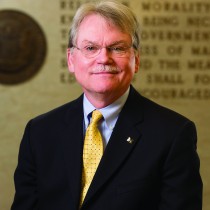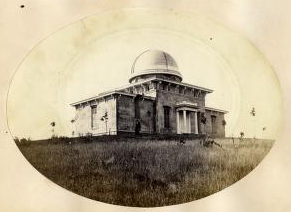Magazine

Time for Restoration
By Terrence J. McDonald
For most of human history, no one had the faintest idea of the exact time. Because we have the archives of the Detroit Observatory here at the Bentley, we know that the exact time arrived in Ann Arbor on June 29, 1860, when a telegraph line permitted the mean time clock at the Hamilton College Observatory in New York to communicate with the sidereal clock in the Detroit Observatory on U-M’s campus. This made it possible to calculate the Observatory’s longitude for the first time.
With the longitude in hand, and the ability to observe the movement of stars between the two observatories, the precise time was established.
By 1863, the Observatory was telegraphing the correct time to Detroit, where a ball atop the Smith Jewelry Store would drop at exactly noon. A local business in Ann Arbor performed the same service with a whistle. This was a critical development for businessmen who needed to know the correct time to enforce time-bound business con.tracts: e.g. “I offer you my corn at this price until 5 p.m. Friday.” The Observatory was even financed by gifts from the Detroit business community to U-M President Henry P. Tappan, which is why it’s called the Detroit Observatory in the first place.
This was the first time, but by no means the last, that the research of the University would serve the needs of the state. Tappan built the Observatory, which opened in 1854, to be the first research instrument on campus and thereby to transform what he thought was a “college” into a real “university” distinguished not only by its teaching, but by its search for new knowledge.
It worked.
The first two University astronomers who worked there—Franz Brunnow (1854-1863) and his student James Watson (1863-1878)—moved rapidly into the front ranks of astronomers in the world, setting the bar high for the University’s nascent research mission. A perfect restoration of the original Observatory building and its equipment—partially funded by loyal donors—was con.ducted 20 years ago. That work saved this second-oldest building on campus and its original site, and made it one of the few extant observatories in America to retain its original telescopes from the 1850s in work.ing condition, in their original mounts. It is now managed by the Bentley.

The Detroit Observatory circa 1861.
Focus groups with faculty and community members have revealed that the site has been underutilized because it lacks proper access to and facilities for those with disability or health issues (e.g. restrooms). There’s also a range of inadequacies in modern teaching space, power supply for digital teaching and display equipment, and HVAC to permit year-round use.
That’s why, this past semester, the Regents approved a significant addition to the area around the Observatory. This new project will barely touch the original building. But it will remedy most of the problems leading to under-use by adding 6,000 square feet of new teaching and display space beneath and to the rear of the original building, including an elevator that will ease access to the first floor of the Observatory.
It is a difficult site to build on and an important original building to keep safe. And so it is an expensive project. But a perfect project for the University’s third century of distinguished research.
